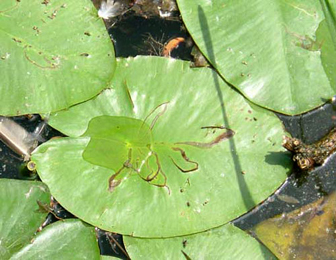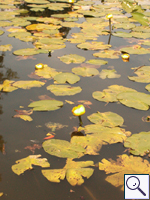|
||||||
|
NUPHAR. Yellow Water-Lilies. [Nymphaeaceae] |
|
|
Three species of Nuphar are recorded in Britain. These include the native Yellow Water-lily (N. lutea) and the rare Least Water-lily (N. pumila). The BSBI provide a downloadable plant crib for Nuphar. Four British miners are recorded on Nuphar. The crambid Parapoynx stratiotata feeds between spun leaves of Nuphar in Britain and elsewhere. A key to the European miners recorded on Nuphar is provided in Bladmineerders van Europa. |
|
Key for the identification of the known mines of British |
1a > Tunnel-like mine, open at both ends |
1b > Leaf-mine |
| 2 > Tunneler: The larvae of a number of species of Chironomidae (non-biting midges) live in tunnels in decaying leaf sheaths under water. Their tunnels are open at both ends, and the larvae feed on particles they obtain from a water current they create in the tunnels. They do not feed on tissues of their 'hostplant' and therefore are not strictly miners. |
|
Cricotopus trifasciatus (Meigen, 1813) [Diptera: Chironomidae]. |
3a > Leaf-miner: Mines visible from a distance as long, elegant corridors in the leaf upper-surface, often several in a leaf. The corridors run towwards to insertion of the the underwater petiole. From this point the larvae descend as borers into the petiole and finally pupate there. A part of the pupariria is thin-walled and emerges in August. The other pupariria are thick-walled; they hibernate in the petiole and rise the the surface next spring, after the petiole has rotted away (Hering, 1947a) |
 Mines of Hydromyza livens on Nuphar lutea Image: © Willem Ellis (Bladmineerders van Europa) |
|
Hydromyza livens (Fabricius, 1794) [Diptera: Scathophagidae]. |
3b > Leaf-miner: Full depth or lower-surface blotch, usually near the attachement of the petiole. Older larvae do not mine any longer but live in a flat case, made out of leaf fragments, and cause window feeding at the leaf underside. It mines the leaf for the first three days and then forms a flat case from which the larva feeds. |
|
Elophila nymphaeata (Linnaeus, 1758) [Lepidoptera: Crambidae]. |
3c > Leaf-miner: When young, the larva mines mainly the leaves or the stem of Sparganium or Nuphar lutea. It hibernates. Later it lives amongst spun leaves just below the surface of the water. Pupation in a white silk cocoon attached to the foodplant at or just below the water-level (Belgian Lepidoptera). Long narrow corridor, on or alongside the midrib. The corridor may descend below the water surface, and does contain frass. After some time the larva cuts itself a case out of the mine, and continues living free, partly under water. |
|
Nymphula nitidulata (Hufnagel, 1767) [Lepidoptera: Crambidae]. |
| Last updated 06-Jul-2019 Brian Pitkin | ||

